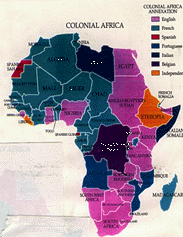
 Africa Under Colonization
Africa Under Colonization

Africa's downfall can be traced back to the Eastern and Western Slave Trades. Firstly, these trades depleted Africa of millions of Black lives. These were men and women needed to plant crops, create technology, run government, etc. Secondly, the Slave Trades turned African nations and peoples against each other as greed and survival necessitated involvement in the Slave Trade. The amount of warfare and distrust generated throughout this period is incalculable. Entire societies collapsed or disappeared altogether. And the few Africans who managed to survive these Holocausts---either by conspiring with the enemy or by fleeing to the interior of the continent---would be unable to escape Europe's second coming. |
the overall consequence of slaving on agricultural activities were negative. Labour was drawn off from agriculture and conditions became unsettled.
Walter Rodney, How Europe Underdeveloped Africa |
 | In 1885 the major powers of Europe gathered in Berlin and decided Africa's fate, carving up the continent to their liking. By 1905 some European power or another had laid claim to nearly every piece of African soil; only Ethiopia and Liberia escaped. Colonial Africa was divided up among a host of European powers including Great Britain, France, Spain, Portugal, Italy, and Belgium. The vast majority of these colonized nations did not receive independence until the 1950s and 60s. The Europeans now came not for people, but for the resources the continent held. The colonizers came with new guns, new cannons, and new methods with which to assault the Slave Trade weakened continent. Africans in the way of these invaders were either displaced or put to work. Those who rebelled were banished from their own land or killed. |
The partition of Africa was, as we all recognise, due primarily to the economic necessity of increasing the supplies of raw materials and food to meet the needs of the industrialized nations of Europe
Lady Lugard, A Tropical Dependency |
The names of the many Africans who witnessed this second European onslaught are numerous: the Xhosa, the Zulu, the Ashanti, the Matabele, the Maasi, the Hutu, and the Tutsi are but a meager few. None would be immune from this new quest for greed. |
Our country is gone and our cattle; we have nothing to live for. Our women are deserting us; the white man does as he likes with them. We are the slaves of the white man; we are nobody, and have no rights or laws of any kind.
Matabele Herdsman |

The Belgian Congo
The atrocities and sufferings of an entire continent are too numerous to recount in this small piece. But an example can be given of one to display the horrors suffered by all. |
In the early 1920s the European nation of Belgium came to control a large region of African land in the country now known as Zaire. Then called the Belgian Congo, it was ruled ruthlessly by King Leopold II and plundered for its main resource, rubber. To gain this precious commodity the Belgians worked the native inhabitants into near genocide. Refusal to "work rubber" often met with mutilation, beatings, and death. |
Of floggings and burnings of villages, of rape and mutilation, of natives being used for revolver practice, and as human experiments to test the efficacy of dynamite cartridges; of "hostage-houses" in which men, women and children perished...
E.D. Morel, The Black Man's Burden |
 | A typical punishment for the Africans was mutilation. Belgian soldiers and sentries often chopped off the hands and feet of men, women and children as warnings and reminders to others. Pictured here is a young girl mutilated by Belgian sentries. |
 | Punishing one's loved ones was a common Belgian practice. Thus the price of not "working rubber" may be the life or safety of one's relatives, spouse, or children. Pictured here is a father who is left to contemplate upon the severed hands and feet of his seven-year-old daughter. |
It is blood-curdling to see them (the soldiers) returning with the hands of the slain, and to find the hands of young children amongst the bigger ones evidencing their bravery...The rubber from this district has cost hundreds of lives, and the scenes I have witnessed, while unable to help the oppressed, have been almost enough to make me wish I were dead... This rubber traffic is steeped in blood, and if the natives were to rise and sweep every white person on the Upper Congo into eternity, there would still be left a fearful balance to their credit.
Belgian Official |

Holocaust: The Numbers
It is estimated that during the period of colonization, King Leopold II of Belgium reduced the Congo Free State's population by some 50%. The death toll is estimated in the millions. How many more succumbed to the HOLOCAUST which ravaged the continent may remain forever unknown. (Photos and Information courtesy of The Scramble for Africa by Muriel E. Chamberlain, The West and the Rest of Us by Chenweizu, How Europe Underdeveloped Africa by Walter Rodney, The Black Man's Burden by ED Morel and The Destruction of Black Civilization by Chancellor Williams) |


 Africa Under Colonization
Africa Under Colonization 




![]()